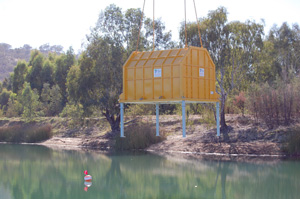For the next two weeks, Nancy Rader, professor of psychology, will monitor the psychological stability of Australian native Lloyd Godson while he is isolated in an 8-by-10-foot tank under 15 feet of water in Albury-Wodonga, Australia. Staff Writer Nathaniel Weixel spoke with Rader via e-mail about the BioSUB project and the psychological and environmental impacts of the research.

Nathaniel Weixel: How did the BioSUB project get started?
Nancy Rader: Lloyd Godson is a marine biologist, scuba diver and adventurer who had the idea it would be interesting and exciting to see whether he could live under water in a self-sustaining habitat for two weeks. He applied to the Australian Geographic “Live Your Dream” contest and won the prize of $50,000. Part of what he’s doing involves educating students, part involves applying science and using new technologies, part involves looking at how someone survives an alien environment and isolation psychologically, and the last part is just pure adventure.
NW: How did you get involved?
NR: I met Lloyd at a Habitation conference sponsored by NASA in February 2006. Lloyd and I chatted, and he invited me to participate in his project by monitoring his psychological responses while he was living in his underwater habitat.
NW: Have you ever been involved in a research project like this before?
NR: I have done research in the area of the effect of the environment on subjective well-being, cognitive performance and physiological measures. I have not worked with someone in an extreme environment, like the BioSUB habitat, to monitor their psychological state. I am hoping to conduct research in Antarctica on this topic in the future.
NW: Are the wetlands a protected area? How does BioSUB minimize its impact?
NR: The Wonga Wetlands is a protected area. The site of the now-submerged BioSUB habitat is a professional diving site … under the auspices of the Wetlands, but is not a wildlife preservation location. Lloyd did go through an environmental protection review process. To minimize the impact of the BioSUB Project, he has used a potable quality paint so the aquatic life are unaffected by the paint, and he designed the BioSUB so that the bottom of the pond is not disturbed.
NW: What are you monitoring Lloyd for?
NR: I am monitoring Lloyd for changes in mood, cognitive functioning and physiological indices of stress, such as heart rate and respiration.
NW: What techniques are you using?
NR: Questionnaires relating to mood are posted on a Web site which Lloyd will be able to access while in the BioSUB habitat. … Lloyd will do the cognitive testing using a Palm Pilot, and these results will be sent to me daily.
NW: What are the future implications of this project?
NR: It is a testing ground for a number of science and commercial products. For example, six students from an advanced biology class at Cascade High School in Idaho have designed the BioCoil, a system of algae that will remove carbon dioxide and provide oxygen while Lloyd is in the underwater habitat. Other interesting products include a solar system for providing light that will mimic the light intensity outside the habitat. A Like-A-Fish device being designed by an Israeli scientist will extract oxygen from water. Lloyd will be generating power using a bicycle he has built. In general, this project will encourage people to think more about sustainability, demonstrate scientific principles related to sustainability and reveal something about how humans might live in alien environments.
NW: What happens if Godson gets in trouble, such as oxygen problems or if it leaks?
NR: Lloyd has several safety features built in and the habitat has been well designed and tested. An electronic monitoring device will let him and his team on shore know if the gases in the atmosphere are not what they should be. There will also be camera monitoring of Lloyd. However, if he gets into trouble, he can exit at any time. As an extra safety measure, the clear bottom hatch is embedded into a larger one that has release clamps that can be operated from the outside.







